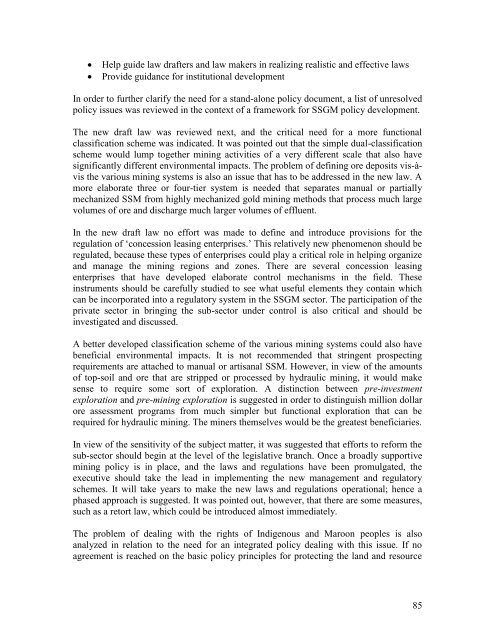SITUATION ANALYSIS OF THE SMALL-SCALE GOLD ... - WWF
SITUATION ANALYSIS OF THE SMALL-SCALE GOLD ... - WWF
SITUATION ANALYSIS OF THE SMALL-SCALE GOLD ... - WWF
You also want an ePaper? Increase the reach of your titles
YUMPU automatically turns print PDFs into web optimized ePapers that Google loves.
Help guide law drafters and law makers in realizing realistic and effective laws<br />
Provide guidance for institutional development<br />
In order to further clarify the need for a stand-alone policy document, a list of unresolved<br />
policy issues was reviewed in the context of a framework for SSGM policy development.<br />
The new draft law was reviewed next, and the critical need for a more functional<br />
classification scheme was indicated. It was pointed out that the simple dual-classification<br />
scheme would lump together mining activities of a very different scale that also have<br />
significantly different environmental impacts. The problem of defining ore deposits vis-àvis<br />
the various mining systems is also an issue that has to be addressed in the new law. A<br />
more elaborate three or four-tier system is needed that separates manual or partially<br />
mechanized SSM from highly mechanized gold mining methods that process much large<br />
volumes of ore and discharge much larger volumes of effluent.<br />
In the new draft law no effort was made to define and introduce provisions for the<br />
regulation of „concession leasing enterprises.‟ This relatively new phenomenon should be<br />
regulated, because these types of enterprises could play a critical role in helping organize<br />
and manage the mining regions and zones. There are several concession leasing<br />
enterprises that have developed elaborate control mechanisms in the field. These<br />
instruments should be carefully studied to see what useful elements they contain which<br />
can be incorporated into a regulatory system in the SSGM sector. The participation of the<br />
private sector in bringing the sub-sector under control is also critical and should be<br />
investigated and discussed.<br />
A better developed classification scheme of the various mining systems could also have<br />
beneficial environmental impacts. It is not recommended that stringent prospecting<br />
requirements are attached to manual or artisanal SSM. However, in view of the amounts<br />
of top-soil and ore that are stripped or processed by hydraulic mining, it would make<br />
sense to require some sort of exploration. A distinction between pre-investment<br />
exploration and pre-mining exploration is suggested in order to distinguish million dollar<br />
ore assessment programs from much simpler but functional exploration that can be<br />
required for hydraulic mining. The miners themselves would be the greatest beneficiaries.<br />
In view of the sensitivity of the subject matter, it was suggested that efforts to reform the<br />
sub-sector should begin at the level of the legislative branch. Once a broadly supportive<br />
mining policy is in place, and the laws and regulations have been promulgated, the<br />
executive should take the lead in implementing the new management and regulatory<br />
schemes. It will take years to make the new laws and regulations operational; hence a<br />
phased approach is suggested. It was pointed out, however, that there are some measures,<br />
such as a retort law, which could be introduced almost immediately.<br />
The problem of dealing with the rights of Indigenous and Maroon peoples is also<br />
analyzed in relation to the need for an integrated policy dealing with this issue. If no<br />
agreement is reached on the basic policy principles for protecting the land and resource<br />
85
















